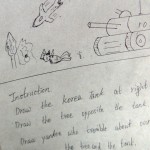Pictured above: An English lesson in the DPRK. Source here.
Andrei Lankov writes in the Korea Times:
Mathematics is the most abstract of all sciences. It is as free as possible from dirty (and/or lofty) political passions and human emotions ― at least this is what most people believe.
But there are exceptions to this rule. Considering the North Korean regime’s habit of politicizing everything, one should not expect North Korean math textbooks to be free from politics. Indeed, they are not.
For the purposes of this column I had a brief look through the Year Two math textbook for North Korean primary schools, published in 2003 (or officially Year 91 of the “Juche Era”). This textbook is a specimen of politicized math, North Korean style, and I would like to introduce some representative gems of this treasure chest.
Admittedly, the majority of the questions in the textbook are not political ― indeed they have no back story at all. Children are required to deal with abstract numbers and areas. However, some 20-25 percent of the questions are different. They include a story to make math more interesting and relevant. Most of the stories are quite innocent ― about a train’s timetable or children’s games. But some are not.
Take an engaging quiz from page 17: “During the Fatherland Liberation War (North Korea’s official name for the Korean War) the brave uncles of Korean People’s Army killed 265 American imperialist bastards in the first battle. In the second battle they killed 70 more bastards than they had in the first battle. How many bastards did they kill in the second battle? How many American imperialist bastards did they kill all together?’
On page 24, some American imperialist bastards fared better and were lucky to survive the pious slaughter: ‘During the Fatherland Liberation War the brave uncles of the Korean People’s Army in one battle killed 374 American imperialist bastards, who are brutal robbers. The number of prisoners taken was 133 more than the number of American imperialist bastards killed. How many bastards were taken prisoner?’
The use of math for body counts is quite popular ― there are four or five more questions like this in the textbook. But in order not to be repetitive it would be best to move on to other lofty topics presented to the children.
As every North Korean child is supposed to believe, his South Korean peers spend days and nights fighting the American imperialist bastards. So this also creates a good opportunity to apply simple math.
On page 138 one can find the following question: “South Korean boys, who are fighting against the American imperialist wolves and their henchmen, handed out 45 bundles of leaflets with 150 leaflets in each bundle. They also stuck 50 bundles with 50 leaflets in each bundle. How many leaflets were used?’
Page 131 also provides children with a revision question about leaflet dissemination: `Chadori lives in South Korea which is being suppressed by the American imperialist wolves. One day he handed out five bundles of leaflets, each bundle containing 185 leaflets. How many leaflets were handed out by Chadori?’
That said, North Korean children are not supposed to be too optimistic. Life in South Korea is not just composed of heroic struggles but also great suffering. On page 47 they can find the following question: `In one South Korean village which is suffering under the heels of the American imperialist wolf-like bastards, a flood destroyed 78 houses. The number of houses damaged was 15 more than the number destroyed. How many houses were damaged or destroyed in this South Korean village all together?’
These sufferings are nicely contrasted with the prosperity enjoyed by the happy North Koreans. On the same page, the question about destroyed South Korean houses is immediately followed by this question: `In the village where Yong-shik lives, they are building many new houses. 120 of these houses have 2 floors. The number of houses with 3 floors is 60 more than the number of houses with two floors. How many houses have been built in Yong-shik’s village?’
Indeed feats of productive labor are often the topics of North Korean questions, with robots, tractors, TV sets and houses mentioned most frequently. Interestingly, in some cases questions might produce results which were clearly not intended by the compilers. For example, on page 116 one can find the following question: ‘In one factory workers produced 27 washing machines in 3 days. Assuming that they produce the same number of washing machines every day, how many machines do they produce in one day?’ One has to struggle hard to imagine a factory which manages to produce merely “nine” washing machines a day, but the irony clearly escapes the textbook’s authors (after all, a washing machine is a very rare luxury item in North Korea).
Activists love to say that everything is political. Whether this is true in general, I know not, but primary school math textbooks in North Korea are seriously political indeed.
Read the full story here:
Mathematics ― a la North Korea
Korea Times
Andrei Lankov
2011-8-28

